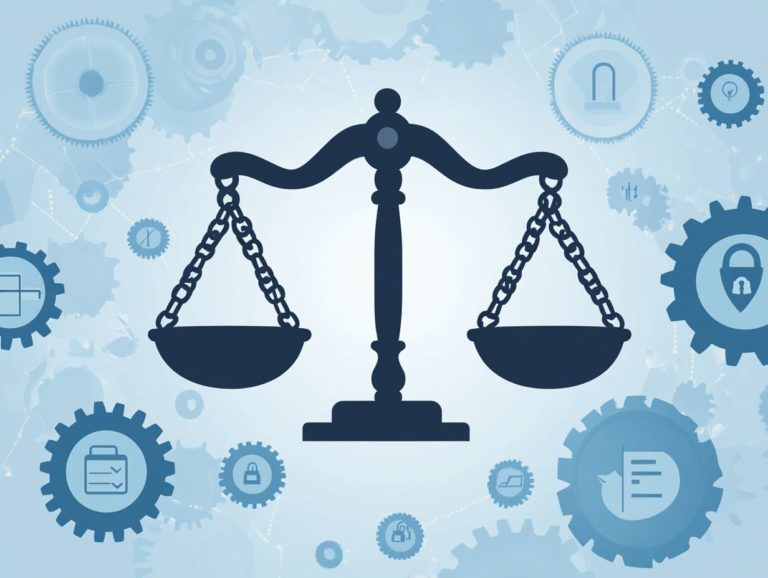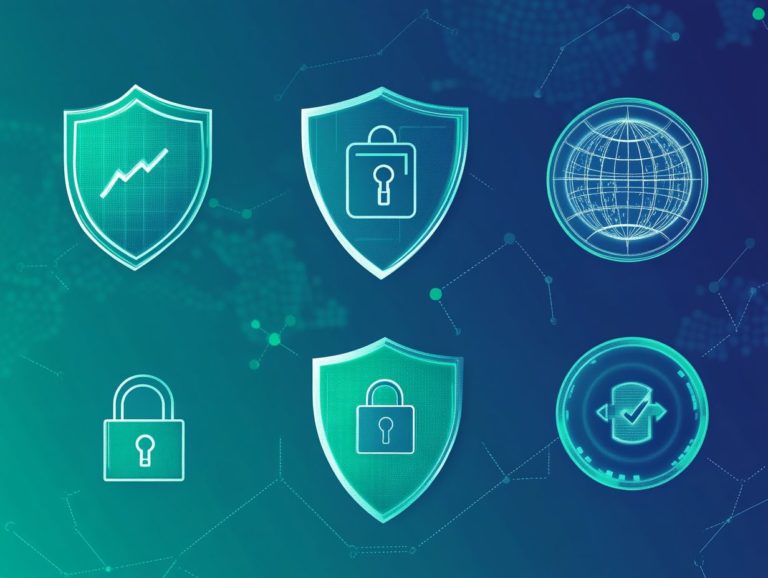best practices for cyber risk management
In today’s digital landscape, the threat of cyber attacks looms larger than ever, making effective cyber risk management essential for organizations of all sizes.
This guide provides you with a comprehensive overview of how to navigate the intricate world of cyber risks. From identifying potential threats and assessing their impact to developing management plans and implementing robust security measures, you ll find best practices that can fortify your organization.
You ll also delve into the crucial role of employee education, the importance of continuous monitoring, and how cyber insurance can bolster your defenses. With insights tailored for everyone from small businesses to large enterprises this guide equips you with the tools necessary to confront cyber challenges head-on.
Dive in to uncover strategies for safeguarding your digital assets and ensuring long-term resilience in the face of evolving threats.
Contents
- Key Takeaways:
- 1. Understanding Cyber Risk Management
- 2. Identifying Potential Cyber Risks
- 3. Assessing the Impact of Cyber Attacks
- 4. Developing a Cyber Risk Management Plan
- 5. Implementing Security Measures
- 6. Regularly Updating and Testing Security Systems
- 7. Educating Employees on Cybersecurity
- 8. Monitoring and Detecting Cyber Threats
- 9. Responding to Cyber Attacks
- 10. Recovering from Cyber Attacks
- 11. Evaluating and Improving Cyber Risk Management Strategies
- 12. Staying Informed about Emerging Cyber Threats
- 13. Collaborating with Other Organizations for Cybersecurity
- 14. Cyber Risk Management for Small Businesses
- 15. The Role of Cyber Insurance in Risk Management
- Frequently Asked Questions
- What are some best practices for cyber risk management?
- What should I do if my business experiences a cyber attack?
- How often should risk assessments be performed?
- What are some examples of strong security protocols?
- Why is having an incident response plan important?
- What is the role of employee training in cyber risk management?
- How can organizations stay updated on the latest cybersecurity threats and best practices?
Key Takeaways:

Developing a comprehensive plan is crucial for effective cyber risk management. Regularly updating security measures and educating employees can help prevent and mitigate cyber attacks. Additionally, understanding the role of risk management in cybersecurity and collaborating with other organizations while staying informed about emerging threats can strengthen cyber risk management strategies.
1. Understanding Cyber Risk Management
Understanding cyber risk management is essential if you aim to protect your digital assets and meet regulatory standards. Effective cybersecurity starts with how to identify and assess cyber risks within your organization and evaluating the associated vulnerabilities.
Implement a risk management plan that aligns with established standards like NIST and ISO. For a comprehensive approach, consider following a cybersecurity risk management: a step-by-step guide. As cyber threats continue to evolve, maintaining a robust security posture necessitates ongoing risk assessment and improvement strategies.
You must recognize that poor risk management jeopardizes your compliance status and places your critical assets at significant risk. By adhering to established frameworks such as NIST and ISO, you can create a structured approach to identify, evaluate, and address your cyber risks.
This proactive methodology fosters a culture of security awareness and encourages continuous evaluation and adaptation to ever-changing threats. Regular risk assessments enable you to address vulnerabilities swiftly, thereby enhancing your defenses and maintaining trust with your stakeholders and clients.
2. Identifying Potential Cyber Risks
Identifying potential cyber risks forms the bedrock of a robust cybersecurity strategy, enabling you to mitigate vulnerabilities and defend against emerging threats.
You may face various types of cyber risks, from insider threats where employees may unwittingly or maliciously compromise sensitive data to external attacks like phishing schemes and ransomware incidents. The importance of threat intelligence cannot be overstated; it serves as an invaluable resource that aids in pinpointing vulnerabilities and understanding the tactics employed by cyber adversaries.
For instance, conducting a thorough risk analysis might involve simulating attack scenarios to evaluate how well your systems can withstand specific threats. By employing real-time monitoring and analysis tools, you can continuously assess your risk levels, allowing you to adapt your security measures to the ever-evolving landscape of cyber challenges.
3. Assessing the Impact of Cyber Attacks
Assessing the impact of cyber attacks is crucial for understanding the potential damage to your business, including data breaches and the operational costs that follow during recovery.
This thorough evaluation not only sheds light on immediate financial losses but also highlights the long-term reputational risks that could tarnish your image and erode customer trust.
By examining the operational disruptions these incidents can cause, you can better prepare for future challenges. Implement effective recovery strategies, like rapid incident response and robust backup solutions.
Efficient risk assessment processes are vital in pinpointing vulnerabilities, enabling you to develop proactive measures that significantly lessen the severity and duration of any adverse effects stemming from cyber threats.
Start assessing your cyber risks today to protect your organization!
4. Developing a Cyber Risk Management Plan
Creating a strong cybersecurity plan is essential for establishing a robust cybersecurity program that effectively mitigates risks through the implementation of internal controls and comprehensive risk strategies.
By outlining necessary steps such as assessing current vulnerabilities and setting risk tolerance levels you can create a framework that addresses immediate concerns and prepares you for potential future threats.
Effective communication tools ensure that all stakeholders are informed and engaged in the process, fostering a culture of security awareness.
Regularly evaluating this risk management framework is crucial. It allows your team to adapt to new challenges and evolving risks, ensuring that your organization remains resilient in an ever-changing digital landscape.
5. Implementing Security Measures

Implementing security measures is essential to protect what matters most your organizational assets. This involves setting up security measures, providing employee training, and establishing robust authentication mechanisms.
Prioritizing comprehensive employee training programs is vital. Educating your staff on recognizing security threats and adhering to best practices is key.
Strong authentication processes further protect sensitive information by verifying user identities, significantly reducing the risk of unauthorized access.
Integrating security controls into incident response plans is vital for swiftly addressing potential breaches and minimizing their impact.
Continuous monitoring systems are important; they detect anomalies in real-time and enhance your overall cybersecurity strategy, fostering a proactive defense against evolving threats.
6. Regularly Updating and Testing Security Systems
Regular updates are vital to stay ahead of threats don’t wait for an attack to act. Updating and testing your security systems is crucial for identifying vulnerabilities and ensuring your cybersecurity program effectively tackles evolving threats.
Continuous monitoring provides real-time insights into system performance and risk exposure. Security audits are vital for assessing the effectiveness of existing measures. Conducting audits regularly allows you to identify gaps in your security framework, enabling timely adjustments.
Integrating regular updates into your risk assessment strategy fosters a culture of proactive vigilance, ensuring you are well-equipped to face new challenges in the digital landscape.
7. Educating Employees on Cybersecurity
Educating employees on cybersecurity is essential for fostering a culture that prioritizes data protection and minimizes risks of insider threats or accidental breaches.
When team members are well-versed in identifying vulnerabilities and adhering to established security protocols, they become the first line of defense in your organization s risk management strategy.
A comprehensive training program ensures each individual understands their role in safeguarding sensitive information, significantly reducing the likelihood of costly data breaches.
A knowledgeable workforce not only complies with legal regulations but builds trust with clients and stakeholders, enhancing your organization s reputation.
Investing time and resources in cybersecurity education cultivates a proactive environment where security is a shared responsibility. Start your risk assessment today!
8. Monitoring and Detecting Cyber Threats
Monitoring and detecting cyber threats is essential to maintaining vigilance against ever-evolving vulnerabilities. This ensures a swift response in the event of a security breach.
A comprehensive approach involves utilizing various monitoring systems, such as intrusion detection systems (IDS) and security information and event management (SIEM) solutions. These tools help identify unusual patterns in network traffic.
Using these tools as part of your response plan enables real-time analysis and quicker reactions. This ensures potential threats are neutralized before they escalate.
Leveraging threat intelligence gives valuable insights into emerging risks and threat actors. This allows you to adopt proactive measures instead of merely reacting to incidents.
By encouraging constant monitoring and quick adjustments, you can significantly enhance your overall cybersecurity posture.
9. Responding to Cyber Attacks
Responding to cyber attacks effectively is crucial for minimizing damage and implementing risk mitigation strategies. This helps you recover swiftly and efficiently from incidents.
An effective incident response plan includes key components like a thorough risk assessment, the establishment of security controls, and clearly defined recovery strategies.
By identifying and prioritizing potential vulnerabilities, you can create layered defenses. This ensures your response is both timely and robust.
Preparedness is vital in reducing operational costs associated with attacks. Proactive measures can prevent incidents from escalating and requiring more extensive recovery efforts.
This comprehensive approach safeguards your assets and enhances your organizational resilience. Ultimately, it transforms how you manage and recover from threats.
10. Recovering from Cyber Attacks

Recovering from cyber attacks involves a multifaceted process. It demands effective recovery strategies to minimize business impact and restore normal operations while evaluating your overall cybersecurity program.
After an incident, act quickly to contain the threat, eliminate it, and get your systems back up and running. Document the incident to understand how the breach occurred. Open communication with stakeholders is vital to maintaining their trust during this turbulent time.
For the long haul, your strategies should include thorough evaluations of your existing security measures. Regular training for employees cultivates a culture of cybersecurity awareness.
Ongoing risk assessments are essential for pinpointing vulnerabilities and strengthening your defenses. This ensures operational stability and resilience against potential future threats.
11. Evaluating and Improving Cyber Risk Management Strategies
Evaluating and improving your cyber risk management strategies is crucial for adapting to evolving threats. It ensures compliance with regulations and strengthens your cybersecurity program using frameworks like ISO standards.
By adopting continuous assessment practices, you can identify vulnerabilities and take proactive measures more effectively. Using key metrics like incident response time, threat detection rates, and user awareness training effectiveness allows you to measure the success of your risk management initiatives.
Incorporating feedback from your staff sharpens your ability to respond quickly to emerging risks. This iterative process not only reinforces your overall cybersecurity posture but also fosters a culture of resilience, making security considerations an integral part of your daily operations.
12. Staying Informed about Emerging Cyber Threats
Staying informed about emerging cyber threats is essential for adapting your cybersecurity strategies. Use threat information and continuous monitoring to anticipate and respond to regulatory changes.
In today’s rapidly evolving digital landscape, maintaining awareness of industry trends is crucial. Stay engaged with various resources, such as cybersecurity reports, industry publications, and webinars, to gather valuable insights on potential vulnerabilities.
Utilizing threat intelligence platforms aids in identifying these threats and enables proactive measures that strengthen your defenses. Continuous monitoring is vital; it allows you to detect anomalies in real time and make informed decisions that safeguard sensitive information.
This holistic approach ensures that your organization can respond effectively to both established and emerging cyber risks, keeping you one step ahead in the ever-changing digital battleground.
13. Collaborating with Other Organizations for Cybersecurity
Collaborating with other organizations for cybersecurity significantly enhances the effectiveness of your cybersecurity program. By using shared resources, communication tools, and expertise from various risk management frameworks, you can create a more resilient defense.
Partnerships foster a robust ecosystem where your team can exchange vital intelligence about emerging threats, vulnerabilities, and best practices. Pooling collective insights keeps you ahead of cybercriminals, employing strategies that would be elusive in isolation.
Integrating cybersecurity insurance acts as a safety net, allowing your security teams to better manage the financial risks associated with breaches. Close collaboration and ongoing dialogue establish a proactive defense mechanism built on mutual trust and shared accountability, leading to a more secure environment for everyone involved.
14. Cyber Risk Management for Small Businesses
Cyber risk management is essential for small business owners, protecting critical digital assets while balancing operational costs with a complete risk management plan tailored to unique challenges.
With limited resources and expertise, your business may be particularly vulnerable to various cyber threats. The landscape is increasingly complex, with rising incidents of data breaches and ransomware attacks underscoring the necessity for effective yet affordable cybersecurity measures.
Investing in employee training significantly boosts security awareness and risk management. By enabling your staff with the knowledge to recognize and counter potential threats, you can markedly reduce the risks associated with human error.
This dual approach strengthens defenses and fosters a culture of security within your organization, ensuring that everyone is on the same page when it comes to protecting what matters most.
15. The Role of Cyber Insurance in Risk Management

Cyber insurance plays a pivotal role in your risk management strategy by offering financial protection against potential losses linked to cybersecurity incidents, while also helping you comply with regulatory requirements.
Think of it as your safety net, enabling your business to recover swiftly from data breaches, ransomware attacks, and other cyber threats that could otherwise disrupt operations.
By covering costs associated with incident response, legal fees, and public relations efforts, this type of insurance enables you to manage the aftermath of cyber incidents with greater efficiency.
As you evaluate your options, assess your specific risk exposure, grasp the nuances of policy terms, and consider the insurer s reputation. These factors significantly influence how effectively your coverage can mitigate risks and support your business resilience.
Frequently Asked Questions
What are some best practices for cyber risk management?
Some best practices for cyber risk management include regular risk assessments, implementing strong security protocols, and creating a robust incident response plan, along with effective risk management strategies for cyber threats.
What should I do if my business experiences a cyber attack?
If your business experiences a cyber attack, it is crucial to have an incident response plan in place. Act swiftly to contain the breach, assess the damage, and inform relevant stakeholders.
How often should risk assessments be performed?
Conduct risk assessments at least once a year. If there’s a significant change in technology or operations, do it more often.
What are some examples of strong security protocols?
Strong security protocols include multi-factor authentication and regular software updates. Also, train employees on cybersecurity best practices.
Why is having an incident response plan important?
An incident response plan is essential. It enables quick action during a cyber attack, reducing damage and protecting sensitive data.
What is the role of employee training in cyber risk management?
Employee training is crucial! Many cyber attacks target staff through phishing and social engineering. Proper training helps recognize and avoid these threats.
How can organizations stay updated on the latest cybersecurity threats and best practices?
To stay updated, organizations should attend conferences and workshops regularly. Joining cybersecurity forums and following trusted publications is also important.






